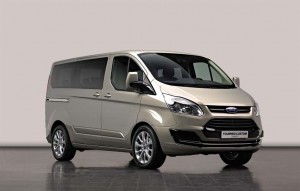
Ford will unveil the new Tourneo Custom Concept van in Geneva. A heavier-duty version, the Transit, will migrate to the U.S. market in 2013.
As part of its One Ford strategy, Ford Motor Co. is rapidly shifting from regional product development to a line-up of global products like the new Fiesta, Focus and Fusion models. The maker will take the next step forward when it unleashes the Ford Tourneo Custom Concept at the upcoming Geneva Motor Show.
The Tourneo Concept is a thinly-disguised prototype for the next-generation Ford Transit van. That’s not to be confused with the smaller Transit Connect which the maker introduced in the U.S. market two years ago. The bigger Transit will soon replace the long-lived Ford E-Van that has become the staple for plumbers, delivery services, shuttle bus operators and just about anyone else who has to haul people and equipment.
Decidedly more modern than the aging E-Van, the Tourneo Concept is a one-ton light-duty passenger van. It adopts a commercial version of the so-called Kinetic Design styling language that struck a responsive chord when used to reshape the 2013 Ford Fusion sedan.
The 8-seat Tourneo Concept is equipped with a wide range of creature comfort and technology features, including Ford’s voice-activated Sync. The new Emergency Assistance system will be programmed to automatically call for help in the event of an accident. The Tourneo Custom Concept features both Lane Departure Warning and a back-up camera. And unlike traditional vans, it will introduce an array of driver and passenger airbags.
The seating system, meanwhile, can be readily adjusted – or removed – to create anything from a shuttle bus to an executive limousine.
“One look at the Tourneo Custom Concept is enough to tell you that it will inject an exciting new spirit into the personal use segment,” says Stephen Odell, chairman and CEO, Ford of Europe. “Our forthcoming new range gives us the opportunity to appeal to new customers with a fresh new direction, and we have seized that opportunity with both hands.”
The version of the van the American market will get is the 2-ton Transit that sources tell TheDetroitBureau.com Ford will reveal later this year. It will feature its own styling cues and will have a rear-wheel-drive powertrain layout, rather than the Tourneo’s front-drive configuration.
“There will be significant differences between the one and two-ton models,” confirms Ford spokesman Mike Levine.
Collectively, the Transit and Tourneo models are essential pieces in the One Ford strategy. In Europe, the van market is positively huge, “a lot like our (U.S.) pickup market,” suggested Levine, generating about 2 million sales annually. While the E-Van doesn’t quite match that volume it is still a significant player in the American market.
Much of the current demand comes from shuttle fleets and other customers who purchase what’s known as the “Cutaway;” the body of the vehicle rolling out of the factory essentially ends right behind the driver’s seat, leaving it to the customer to bolt on a customized body.
When the U.S. version of the Transit goes into production in 2013 Ford plans to continue production of the old E-Van cutaway “well into the decade,” explains Levine. But sources indicate the maker will eventually migrate the Cutaway to the Transit platform, as well.
Specific powertrain details for the RWD Transit will likely be revealed later this year. The Tourneo Custom Concept, however, will use a 155 horsepower version of Ford’s 2.2-liter Duratorq diesel. It will come equipped with Stop-Start capability to further improve mileage and reduce emissions, the maker notes.

When Ford introduced the “new” Transit in 1984 I went down to the Southampton plant where some of them were to built to review the production process for the press kit.
It was most impressive. Built in an old Spitfire factory the plant was somewhat unique in being two stories. Towards the end of the process, body panels were fed from a repository upstairs down by a conveyors to an automated body framing line.
And what a variation in panels there were, as you had long wheelbase, medium wheelbase, long wheelbase, low roof, medium roof, high roof, sliding rear side doors, conventional rear doors and so on. Something like 38 different bodies and a complex system of laser beams, sensors and computers decided how the robots clamped, assembled and welded everything together automatically.
The machine was about the size of a city block and bits entered the abyss at one end and emerged as complete Transit bodies the other. For some reason, though, when I was there it wasn’t in action….
In my struggle to describe this thing for the news release I asked the plant manager what it was called.
He looked at me quizzically, smiled and, in the broadest Hampshire accent shared the truth. “Ah, that there masheen … we call it the Tunnel of Love.”
“The Tunnel of Love,” I said. “Why do you call it that?”
“Because,” the reply came quick as a flash, “every time we put something in there it gets f**ked.”